
The
Stuttgart-based brand
Sporty design
through and through

Ein durch und durch sportlicher
Auftritt
ZUR DEUTSCHEN VERSION |
Mercedes-Benz SLR McLaren 722 Edition
Mercedes-Benz
SLR McLaren 722 Edition Motorracing blood coursing through its veins
Stuttgart/Dubai - The new Mercedes-Benz SLR McLaren 722 Edition displays
thoroughbred motorracing credentials. Featuring more than 300 modified
components, the super sports car serves up a boost in output, more dynamic
chassis tuning, improved aerodynamics and distinctly sporty interior appointments
to thrill even the most demanding of sportscar enthusiasts.
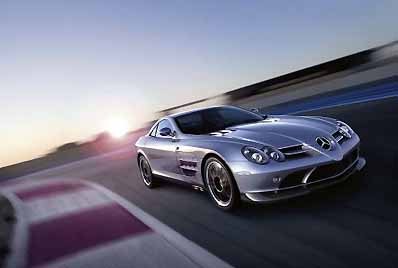 The flawless roads which today lead through the
desert next to Dubai are ideal for demonstrating the pedigree sporting
performance that characterises the
Mercedes-Benz SLR McLaren 722
Edition. Dubai is the up-and-coming business centre of the United Arab
Emirates (UAE). It is the setting for the world's most ambitious construction
projects, including the man-made "Palm Jumeirah" island, and over the course
of recent decades many wealthy sheikhs have become avid automobile aficionados.
It is this flair for the exceptional that links the desert city on the Persian
Gulf and its inhabitants with the Mercedes-Benz SLR McLaren 722 Edition premium
sports car. The new SLR 722 Edition model variant from Mercedes-Benz evokes
memories of a particularly special victory achieved in 1955 by the British
motorracing legend Stirling Moss and his co-pilot Dennis Jenkinson at Mille
Miglia – the classic Italian endurance race – behind the wheel
of a Mercedes-Benz 300 SLR with start number 722 (denoting the car's start
time of 7.22 a.m.). Boasting an impressive output of 478 kW/650 hp, the new
SLR McLaren 722 Edition super sports car not only outperforms its historic
forefather, it even outstrips the scintillating peak performance of the current
SLR model. The new limited-edition series – only 150 models are being
produced, for the most part handcrafted, at the McLaren Formula 1 works in
Woking – is the brand's response to calls from highly discerning SLR
customers for even more sportiness combined with the same high level of everyday
practicality. At the heart of the SLR 722 Edition is a 5.5-litre supercharged
V8 assembled by hand at the Mercedes-AMG engine workshops in Affalterbach,
Germany, based on the "One man, one engine" principle. Among the high-performance
powerplant's major strengths are its exceptionally spontaneous response to
accelerator pedal movements, high torque and that unmistakable V8 sound. The flawless roads which today lead through the
desert next to Dubai are ideal for demonstrating the pedigree sporting
performance that characterises the
Mercedes-Benz SLR McLaren 722
Edition. Dubai is the up-and-coming business centre of the United Arab
Emirates (UAE). It is the setting for the world's most ambitious construction
projects, including the man-made "Palm Jumeirah" island, and over the course
of recent decades many wealthy sheikhs have become avid automobile aficionados.
It is this flair for the exceptional that links the desert city on the Persian
Gulf and its inhabitants with the Mercedes-Benz SLR McLaren 722 Edition premium
sports car. The new SLR 722 Edition model variant from Mercedes-Benz evokes
memories of a particularly special victory achieved in 1955 by the British
motorracing legend Stirling Moss and his co-pilot Dennis Jenkinson at Mille
Miglia – the classic Italian endurance race – behind the wheel
of a Mercedes-Benz 300 SLR with start number 722 (denoting the car's start
time of 7.22 a.m.). Boasting an impressive output of 478 kW/650 hp, the new
SLR McLaren 722 Edition super sports car not only outperforms its historic
forefather, it even outstrips the scintillating peak performance of the current
SLR model. The new limited-edition series – only 150 models are being
produced, for the most part handcrafted, at the McLaren Formula 1 works in
Woking – is the brand's response to calls from highly discerning SLR
customers for even more sportiness combined with the same high level of everyday
practicality. At the heart of the SLR 722 Edition is a 5.5-litre supercharged
V8 assembled by hand at the Mercedes-AMG engine workshops in Affalterbach,
Germany, based on the "One man, one engine" principle. Among the high-performance
powerplant's major strengths are its exceptionally spontaneous response to
accelerator pedal movements, high torque and that unmistakable V8 sound. |
Crankcase with dry-sump
lubrication
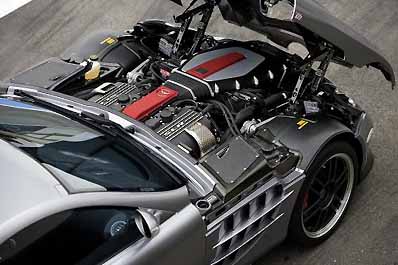 The powerplant's entire engine block with its enclosed
crankcase sump is made from cast aluminium. Each crankshaft is precision-weighted
and revolves in five bearings made from a high-durability material to enable
sustained transmission of the tremendous forces emanating from the supercharged
engine. The forged pistons are only manufactured in extremely small numbers.
Just like the forged lightweight connecting rods, the pistons are measured
and weighed with utmost accuracy before being assigned to individual engines.
This keeps any mass balancing tolerances to an absolute minimum. The pistons
slide inside extremely durable, wear-resistant, low-friction cylinder barrels
made from a special compound which is otherwise only found in race car engines.
Twin oil injection is used for effective piston cooling. The oil cooling
technology employed for the power unit as a whole also draws on the brand's
racetrack experience: a sophisticated dry-sump lubrication system with a
capacity of around eleven litres combines with a five-speed oil suction pump
and a two-speed oil pressure pump to guarantee reliable lubrication under
all driving conditions. One important knock-on effect of this dry-sump
lubrication technology, which is again normally exclusive to race cars, is
that the engine height can be kept low, allowing it to be installed deeper
down in the engine compartment: the result is a low centre of gravity that
fosters dynamic handling. The powerplant's entire engine block with its enclosed
crankcase sump is made from cast aluminium. Each crankshaft is precision-weighted
and revolves in five bearings made from a high-durability material to enable
sustained transmission of the tremendous forces emanating from the supercharged
engine. The forged pistons are only manufactured in extremely small numbers.
Just like the forged lightweight connecting rods, the pistons are measured
and weighed with utmost accuracy before being assigned to individual engines.
This keeps any mass balancing tolerances to an absolute minimum. The pistons
slide inside extremely durable, wear-resistant, low-friction cylinder barrels
made from a special compound which is otherwise only found in race car engines.
Twin oil injection is used for effective piston cooling. The oil cooling
technology employed for the power unit as a whole also draws on the brand's
racetrack experience: a sophisticated dry-sump lubrication system with a
capacity of around eleven litres combines with a five-speed oil suction pump
and a two-speed oil pressure pump to guarantee reliable lubrication under
all driving conditions. One important knock-on effect of this dry-sump
lubrication technology, which is again normally exclusive to race cars, is
that the engine height can be kept low, allowing it to be installed deeper
down in the engine compartment: the result is a low centre of gravity that
fosters dynamic handling. |
Screw compressor power
Efficient cylinder charging is the task of a belt-driven compressor with
two screwshaped aluminium rotors that are Teflon-coated in the interests
of keeping friction low. In order to keep the engine running as efficiently
as possible at all times, the AMG engineers have devised an intelligent engine
management system which independently determines when to deploy the screw
compressor as the engine's rev speed and load change. Consequently, the
supercharger is only called into action when it is really needed. Notwithstanding
this, however, maximum power is always available the instant the driver summons
it by opening the throttle. Apart from the compressor, the engine's electronics
monitor all of the other variables which are relevant to its operation. At
the same time, they ensure optimum operation of the intercoolers' water circuit.
After all, efficient cooling of the charge air is a vital ingredient for
high performance. The intercoolers operate based on the extremely efficient
air-to-water heat exchanger principle: the air which has been compressed
by the compressor, causing it to heat up, is directed through a separate
water circuit to cool it down again. This enables the eight-cylinder powerplant
to maximise its output and torque delivery.
Manual transmission mode for shift
times worthy of a race car
High performance has also been ingrained into the five-speed automatic
transmission, which was developed in-house at Mercedes-Benz and has already
featured in a number of exceptionally powerful models. It has been optimised
to enable it to handle the awesome torque on tap and also offers drivers
the possibility of varying the gearshift characteristics. The transmission
directs the engine's power to the differential and the rear wheels via a
precision balanced drive train made from aluminium and steel. The interplay
of the engine with the gearshift was also subject to modification. For each
of the individually selectable transmission modes – M (Manual) and S
(Sport) on the one hand and C (Comfort) on the other – there is now
a different accelerator pedal characteristic curve, which has been optimised
in line with the varying operating conditions. The end result is an extremely
impressive set of performance figures, even by high-end super sports car
standards: the SLR 722 Edition completes the sprint from 0 to 100 km/h in
a breathtaking 3.6 seconds (SLR 3.8 seconds), with the speedometer needle
proceeding to pass the 200 km/h mark in a mere 10.2 seconds (SLR 10.6 seconds)
and the 300 km/h mark in just 28.0 seconds (SLR 28.8 seconds). Plus, the
top speed of 337 km/h is even higher than that of the current SLR (334 km/h).
New chassis set-up for further enhanced
handling dynamics
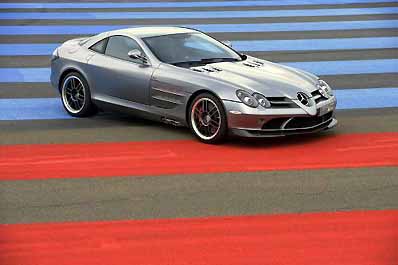 One of the main driving forces behind the enhanced
performance of the SLR 722 Edition is the retuned chassis. Development work
at McLaren's Formula 1 headquarters was based on the set-up of the SLR's
proven aluminium chassis, that is itself the handiwork of experienced race
car developers: wheel guidance is the task of double wishbones at both the
front and rear. The bottom links are arranged in such a way that the wheels
receive a negative camber when the springs compress or when cornering at
speed. This guarantees optimum contact with the road in any situation. Meanwhile,
the axle technology also minimises the degree of diving and squatting while
braking heavily and accelerating respectively. The axle's wishbones are made
from forged aluminium, while cast aluminium is used for the wheel carriers.
This lightweight material boasts a host of advantages compared to conventional
steel constructions, including the far superior response of the suspension
and damping that results from the reduced weight. The relatively long wheelbase
of 2700 millimetres likewise contributes to the exemplary handling
characteristics, with the most notable benefit being the outstanding
straight-line stability, while the wide track combines with the low centre
of gravity to enable high cornering speeds. The chassis construction has
the anti-roll bar positioned above the front axle where it is controlled
via rocker arms, just like on a Formula 1 car. With this setup , the anti-roll
bar does not take up any additional installation space. In this way, the
smooth lines of the underside of the vehicle are not disrupted, which is
vital for the sports car's outstanding aerodynamic characteristics. In the
first phase of chassis development for the Mercedes-Benz McLaren 722 Edition,
various combinations of chassis parameters, such as springing and damping,
underwent a series of tests on the Formula 1 dynamometer in Woking. Then
the Mercedes-Benz and McLaren engineers made further refinements and finalised
the new set-up by performing an extensive series of tests on the road and,
above all, on the race track. The stiffer spring rates and shock absorber
characteristics of the chassis as well as the lowering of the body by 10
mm at both the front and rear are what gives the SLR 722 Edition its increased
directional stability and noticeably further enhanced handling dynamics.
Body roll on bends has been reduced by over 20 percent, allowing the new
SLR 722 Edition to corner at even greater speeds. New 19-inch forged aluminium
wheels also help to improve the handling dynamics of the special-edition
model, their unique, palladium grey design highlighting the car's motor-racing
heritage. Their lower weight compared to conventional wheels reduces the
unsprung masses, making the responsiveness of the SLR 722 Edition all the
sharper. Plus, the 19-inch wheels allow larger brake discs with a diameter
of 390 mm to be fitted on the front axle. Hailing from the Italian manufacturer
"Brembo", the new braking system combines with the carbon-fibre-reinforced
ceramic discs to provide formidable decelerating power which is fully in
keeping with the SLR 722 Edition's scintillating all-round performance.
Exhaustive testing was carried out to develop a new ESP® control system
for this new brake configuration. One of the main driving forces behind the enhanced
performance of the SLR 722 Edition is the retuned chassis. Development work
at McLaren's Formula 1 headquarters was based on the set-up of the SLR's
proven aluminium chassis, that is itself the handiwork of experienced race
car developers: wheel guidance is the task of double wishbones at both the
front and rear. The bottom links are arranged in such a way that the wheels
receive a negative camber when the springs compress or when cornering at
speed. This guarantees optimum contact with the road in any situation. Meanwhile,
the axle technology also minimises the degree of diving and squatting while
braking heavily and accelerating respectively. The axle's wishbones are made
from forged aluminium, while cast aluminium is used for the wheel carriers.
This lightweight material boasts a host of advantages compared to conventional
steel constructions, including the far superior response of the suspension
and damping that results from the reduced weight. The relatively long wheelbase
of 2700 millimetres likewise contributes to the exemplary handling
characteristics, with the most notable benefit being the outstanding
straight-line stability, while the wide track combines with the low centre
of gravity to enable high cornering speeds. The chassis construction has
the anti-roll bar positioned above the front axle where it is controlled
via rocker arms, just like on a Formula 1 car. With this setup , the anti-roll
bar does not take up any additional installation space. In this way, the
smooth lines of the underside of the vehicle are not disrupted, which is
vital for the sports car's outstanding aerodynamic characteristics. In the
first phase of chassis development for the Mercedes-Benz McLaren 722 Edition,
various combinations of chassis parameters, such as springing and damping,
underwent a series of tests on the Formula 1 dynamometer in Woking. Then
the Mercedes-Benz and McLaren engineers made further refinements and finalised
the new set-up by performing an extensive series of tests on the road and,
above all, on the race track. The stiffer spring rates and shock absorber
characteristics of the chassis as well as the lowering of the body by 10
mm at both the front and rear are what gives the SLR 722 Edition its increased
directional stability and noticeably further enhanced handling dynamics.
Body roll on bends has been reduced by over 20 percent, allowing the new
SLR 722 Edition to corner at even greater speeds. New 19-inch forged aluminium
wheels also help to improve the handling dynamics of the special-edition
model, their unique, palladium grey design highlighting the car's motor-racing
heritage. Their lower weight compared to conventional wheels reduces the
unsprung masses, making the responsiveness of the SLR 722 Edition all the
sharper. Plus, the 19-inch wheels allow larger brake discs with a diameter
of 390 mm to be fitted on the front axle. Hailing from the Italian manufacturer
"Brembo", the new braking system combines with the carbon-fibre-reinforced
ceramic discs to provide formidable decelerating power which is fully in
keeping with the SLR 722 Edition's scintillating all-round performance.
Exhaustive testing was carried out to develop a new ESP® control system
for this new brake configuration. |
>High-tech material for exemplary
safety and maximum strength
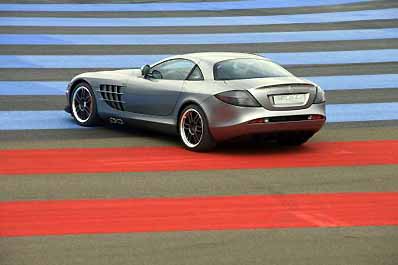 The high-performance sports car's bodyshell bristles
with high tech. The entire bodyshell, including the crash structures at the
front and rear, the occupant cell, the swing-wing doors and the bonnet, is
made from carbon-fibre-reinforced plastic (CRP). This lightweight yet, at
the same time, extremely rigid material is a technology borrowed from the
aviation and space travel industry and has already proven its worth in
ultra-sophisticated Formula 1 race cars. Despite the weightsaving of 50 percent
that this high-tech material represents compared to steel, it is just as
strong, which allowed the engineers to focus on achieving the body's enormous
strength. Plus, in the event of an impact, carbon fibres have a specific
energy absorption that is some four to five time higher than steel or aluminium.
Mercedes-Benz has capitalised on this material property by also fitting two
620-millimetre-long side member elements made from carbon fibre in the front
structure of the SLR 722 Edition; these are capable of absorbing all of the
impact energy in a head-on collision without exceeding the maximum levels
of deceleration that the occupants are able to withstand. In the event of
an impact, the fibres of these two elements tear from front to rear to crumple
in a carefully predetermined manner and thereby produce a constant rate of
deceleration. The super sports car's occupant cell is likewise made from
this high-tech material, offering passengers a very rigid and therefore safe
survival space in an accident. At the rear of the car, the task of absorbing
energy in a crash falls to two internal side members made from laminated
carbon fibre and a sturdy cross member, which together ensure that the occupant
cell remains virtually intact. The occupant protection system also encompasses
adaptive front airbags, which are deployed in two stages depending on the
severity of the impact, head/thorax bags and knee bags, as well as seat belt
tensioners and belt force limiters. The high-performance sports car's bodyshell bristles
with high tech. The entire bodyshell, including the crash structures at the
front and rear, the occupant cell, the swing-wing doors and the bonnet, is
made from carbon-fibre-reinforced plastic (CRP). This lightweight yet, at
the same time, extremely rigid material is a technology borrowed from the
aviation and space travel industry and has already proven its worth in
ultra-sophisticated Formula 1 race cars. Despite the weightsaving of 50 percent
that this high-tech material represents compared to steel, it is just as
strong, which allowed the engineers to focus on achieving the body's enormous
strength. Plus, in the event of an impact, carbon fibres have a specific
energy absorption that is some four to five time higher than steel or aluminium.
Mercedes-Benz has capitalised on this material property by also fitting two
620-millimetre-long side member elements made from carbon fibre in the front
structure of the SLR 722 Edition; these are capable of absorbing all of the
impact energy in a head-on collision without exceeding the maximum levels
of deceleration that the occupants are able to withstand. In the event of
an impact, the fibres of these two elements tear from front to rear to crumple
in a carefully predetermined manner and thereby produce a constant rate of
deceleration. The super sports car's occupant cell is likewise made from
this high-tech material, offering passengers a very rigid and therefore safe
survival space in an accident. At the rear of the car, the task of absorbing
energy in a crash falls to two internal side members made from laminated
carbon fibre and a sturdy cross member, which together ensure that the occupant
cell remains virtually intact. The occupant protection system also encompasses
adaptive front airbags, which are deployed in two stages depending on the
severity of the impact, head/thorax bags and knee bags, as well as seat belt
tensioners and belt force limiters. |
An aerodynamic work of art: even more
downforce and an improved cd figure
Around 100 hours of meticulous work in the wind tunnel also helped boost
the performance of the SLR 722 Edition. Here the developers performed yet
another technical masterstroke by increasing downforce whilst at the same
time reducing the cd (drag coefficient) figure. It's all thanks to the
air-splitter at the front end of the SLR 722 Edition. Consisting of carbon
with a clear-coat finish, the distinctively shaped spoiler lip not only enhances
aerodynamics, it also increases the downforce at the front axle by 128 percent.
Small wheel spoilers, also finished in carbon, reduce air swirl at the rear
axle, making for a smoother airflow and optimising road feel. The spoilers
combine with the airbrake at the rear to produce a further substantial gain
in the downforce acting at the rear axle of the new SLR 722 Edition. The
result is even more precise handling and turn-in at high speeds. The rear-mounted
airbrake is designed to optimise directional stability and braking power:
when the speed exceeds 120 km/h, it automatically rises up at an angle that
has been adjusted in line with the extremely dynamic performance of the new
model. If the driver hits the brakes hard at high speed, the airbrake tilts
up into the airstream automatically. This dynamic modification increases
rearaxle downforce within a fraction of a second, thus partially compensating
for the dynamic axle load distribution during braking, which presses towards
the front axle. A further factor which contributes to the distinctly
sports-oriented configuration is the weight of the SLR 722 Edition, which
the engineers have managed to reduce by around 44 kg. A lighter oil tank
and damper bodies made from aluminium, which have the added benefit of improving
the vibration response of the unsprung masses, contribute to this weight
loss. Last but not least, optimised panelling and insulating materials also
have a positive effect on the vehicle weight. Yet for all these measures,
the high levels of comfort, safety and practicality that have become Mercedes
hallmarks remain unaffected.
Sporty design through and through
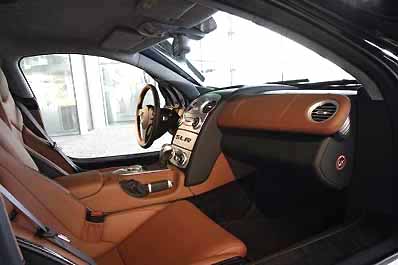 In terms of exterior design, the SLR 722 Edition
features discreet sporty touches, thereby satisfying the desires of keen
gentleman drivers and affluent sports-car collectors – the core target
group – to the letter. The new-look 19-inch light-alloy wheels afford
a perfect view of the red-painted brake callipers and the large brake discs,
emphasising the sheer power and performance that underpins every aspect of
the SLR 722 Edition. In addition, individual components in carbon with a
clearcoat finish highlight the close ties with Formula 1. Plus, the grille-style
design of the black-painted air outlets on the bonnet, not to mention the
front and rear light clusters with their palladium grey surrounds, blend
in perfectly with the carbonfibre look. The SLR 722 Edition is available
with a crystal antimony grey paint finish which creates a vivid impression
of depth and produces an extremely intensive-looking surface structure. Moving
inside, the sports bucket seats, upholstered in a combination of semianiline
leather and Alcantara, offer excellent lateral support, while the colour
contrast provided by the distinctive "300 SL red" stitching throughout the
interior, the 722 insignia on the head restraints and the red seat belts
is designed for added visual impact. The attractive material mix comprising
semi-aniline leather and Alcantara, which gives the interior its characteristic
look and feel, also features prominently on the roof lining and door panels.
Frequently used controls, such as the shift lever and handbrake lever, are
trimmed in easy-grip, moisture-absorbing suede. The sporty design philosophy
that is at the heart of the SLR 722 Edition is also reflected by the widespread
use of carbon throughout the interior. This material, straight from the world
of Formula 1, lends the centre console an extremely puristic look. The restyled
instrument cluster focuses the driver's attention on the key vehicle data,
comprising classic-style round dials with a signal-red background. The
functionality of the multifunction display is given an extra sporty touch
in the form of the AMG RACETIMER. Finally, the designers paid special attention
to the steering wheel as the key link between driver and car: with its combined
leather/suede trim, the rim is extremely easy to grip and helps the driver
to stay in complete control when performing high-speed manoeuvres, as do
the new aluminium shift paddles. In terms of exterior design, the SLR 722 Edition
features discreet sporty touches, thereby satisfying the desires of keen
gentleman drivers and affluent sports-car collectors – the core target
group – to the letter. The new-look 19-inch light-alloy wheels afford
a perfect view of the red-painted brake callipers and the large brake discs,
emphasising the sheer power and performance that underpins every aspect of
the SLR 722 Edition. In addition, individual components in carbon with a
clearcoat finish highlight the close ties with Formula 1. Plus, the grille-style
design of the black-painted air outlets on the bonnet, not to mention the
front and rear light clusters with their palladium grey surrounds, blend
in perfectly with the carbonfibre look. The SLR 722 Edition is available
with a crystal antimony grey paint finish which creates a vivid impression
of depth and produces an extremely intensive-looking surface structure. Moving
inside, the sports bucket seats, upholstered in a combination of semianiline
leather and Alcantara, offer excellent lateral support, while the colour
contrast provided by the distinctive "300 SL red" stitching throughout the
interior, the 722 insignia on the head restraints and the red seat belts
is designed for added visual impact. The attractive material mix comprising
semi-aniline leather and Alcantara, which gives the interior its characteristic
look and feel, also features prominently on the roof lining and door panels.
Frequently used controls, such as the shift lever and handbrake lever, are
trimmed in easy-grip, moisture-absorbing suede. The sporty design philosophy
that is at the heart of the SLR 722 Edition is also reflected by the widespread
use of carbon throughout the interior. This material, straight from the world
of Formula 1, lends the centre console an extremely puristic look. The restyled
instrument cluster focuses the driver's attention on the key vehicle data,
comprising classic-style round dials with a signal-red background. The
functionality of the multifunction display is given an extra sporty touch
in the form of the AMG RACETIMER. Finally, the designers paid special attention
to the steering wheel as the key link between driver and car: with its combined
leather/suede trim, the rim is extremely easy to grip and helps the driver
to stay in complete control when performing high-speed manoeuvres, as do
the new aluminium shift paddles.
 |
READER COMMENTS
| DaimlerChrysler Communications,
Stuttgart (Germany), Auburn Hills (USA), January 2007 |
BACK TO TOP
|
